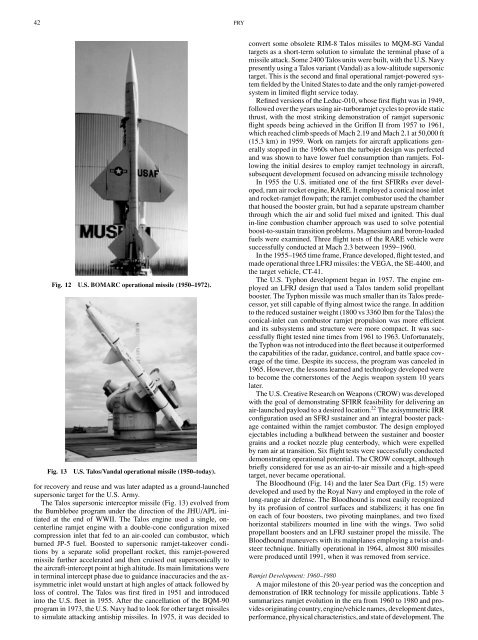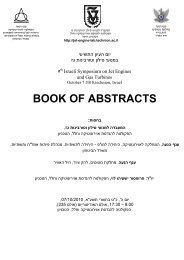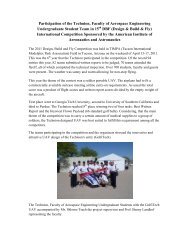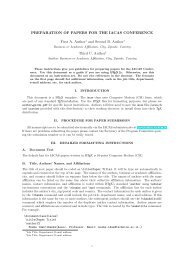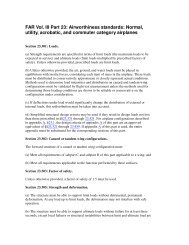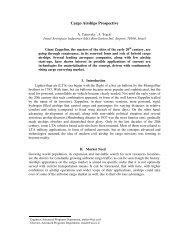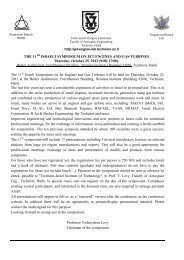A Century of Ramjet Propulsion Technology Evolution - Faculty of ...
A Century of Ramjet Propulsion Technology Evolution - Faculty of ...
A Century of Ramjet Propulsion Technology Evolution - Faculty of ...
Create successful ePaper yourself
Turn your PDF publications into a flip-book with our unique Google optimized e-Paper software.
42 FRY<br />
Fig. 12 U.S. BOMARC operational missile (1950–1972).<br />
Fig. 13 U.S. Talos/Vandal operational missile (1950–today).<br />
for recovery and reuse and was later adapted as a ground-launched<br />
supersonic target for the U.S. Army.<br />
The Talos supersonic interceptor missile (Fig. 13) evolved from<br />
the Bumblebee program under the direction <strong>of</strong> the JHU/APL initiated<br />
at the end <strong>of</strong> WWII. The Talos engine used a single, oncenterline<br />
ramjet engine with a double-cone configuration mixed<br />
compression inlet that fed to an air-cooled can combustor, which<br />
burned JP-5 fuel. Boosted to supersonic ramjet-takeover conditions<br />
by a separate solid propellant rocket, this ramjet-powered<br />
missile further accelerated and then cruised out supersonically to<br />
the aircraft-intercept point at high altitude. Its main limitations were<br />
in terminal intercept phase due to guidance inaccuracies and the axisymmetric<br />
inlet would unstart at high angles <strong>of</strong> attack followed by<br />
loss <strong>of</strong> control. The Talos was first fired in 1951 and introduced<br />
into the U.S. fleet in 1955. After the cancellation <strong>of</strong> the BQM-90<br />
program in 1973, the U.S. Navy had to look for other target missiles<br />
to simulate attacking antiship missiles. In 1975, it was decided to<br />
convert some obsolete RIM-8 Talos missiles to MQM-8G Vandal<br />
targets as a short-term solution to simulate the terminal phase <strong>of</strong> a<br />
missile attack. Some 2400 Talos units were built, with the U.S. Navy<br />
presently using a Talos variant (Vandal) as a low-altitude supersonic<br />
target. This is the second and final operational ramjet-powered system<br />
fielded by the United States to date and the only ramjet-powered<br />
system in limited flight service today.<br />
Refined versions <strong>of</strong> the Leduc-010, whose first flight was in 1949,<br />
followed over the years using air-turboramjet cycles to provide static<br />
thrust, with the most striking demonstration <strong>of</strong> ramjet supersonic<br />
flight speeds being achieved in the Griffon II from 1957 to 1961,<br />
which reached climb speeds <strong>of</strong> Mach 2.19 and Mach 2.1 at 50,000 ft<br />
(15.3 km) in 1959. Work on ramjets for aircraft applications generally<br />
stopped in the 1960s when the turbojet design was perfected<br />
and was shown to have lower fuel consumption than ramjets. Following<br />
the initial desires to employ ramjet technology in aircraft,<br />
subsequent development focused on advancing missile technology<br />
In 1955 the U.S. imitiated one <strong>of</strong> the first SFIRRs ever developed,<br />
ram air rocket engine, RARE. It employed a conical nose inlet<br />
and rocket-ramjet flowpath; the ramjet combustor used the chamber<br />
that housed the booster grain, but had a separate upstream chamber<br />
through which the air and solid fuel mixed and ignited. This dual<br />
in-line combustion chamber approach was used to solve potential<br />
boost-to-sustain transition problems. Magnesium and boron-loaded<br />
fuels were examined. Three flight tests <strong>of</strong> the RARE vehicle were<br />
successfully conducted at Mach 2.3 between 1959–1960.<br />
In the 1955–1965 time frame, France developed, flight tested, and<br />
made operational three LFRJ missiles: the VEGA, the SE-4400, and<br />
the target vehicle, CT-41.<br />
The U.S. Typhon development began in 1957. The engine employed<br />
an LFRJ design that used a Talos tandem solid propellant<br />
booster. The Typhon missile was much smaller than its Talos predecessor,<br />
yet still capable <strong>of</strong> flying almost twice the range. In addition<br />
to the reduced sustainer weight (1800 vs 3360 lbm for the Talos) the<br />
conical-inlet can combustor ramjet propulsion was more efficient<br />
and its subsystems and structure were more compact. It was successfully<br />
flight tested nine times from 1961 to 1963. Unfortunately,<br />
the Typhon was not introduced into the fleet because it outperformed<br />
the capabilities <strong>of</strong> the radar, guidance, control, and battle space coverage<br />
<strong>of</strong> the time. Despite its success, the program was canceled in<br />
1965. However, the lessons learned and technology developed were<br />
to become the cornerstones <strong>of</strong> the Aegis weapon system 10 years<br />
later.<br />
The U.S. Creative Research on Weapons (CROW) was developed<br />
with the goal <strong>of</strong> demonstrating SFIRR feasibility for delivering an<br />
air-launched payload to a desired location. 22 The axisymmetric IRR<br />
configuration used an SFRJ sustainer and an integral booster package<br />
contained within the ramjet combustor. The design employed<br />
ejectables including a bulkhead between the sustainer and booster<br />
grains and a rocket nozzle plug centerbody, which were expelled<br />
by ram air at transition. Six flight tests were successfully conducted<br />
demonstrating operational potential. The CROW concept, although<br />
briefly considered for use as an air-to-air missile and a high-speed<br />
target, never became operational.<br />
The Bloodhound (Fig. 14) and the later Sea Dart (Fig. 15) were<br />
developed and used by the Royal Navy and employed in the role <strong>of</strong><br />
long-range air defense. The Bloodhound is most easily recognized<br />
by its pr<strong>of</strong>usion <strong>of</strong> control surfaces and stabilizers; it has one fin<br />
on each <strong>of</strong> four boosters, two pivoting mainplanes, and two fixed<br />
horizontal stabilizers mounted in line with the wings. Two solid<br />
propellant boosters and an LFRJ sustainer propel the missile. The<br />
Bloodhound maneuvers with its mainplanes employing a twist-andsteer<br />
technique. Initially operational in 1964, almost 800 missiles<br />
were produced until 1991, when it was removed from service.<br />
<strong>Ramjet</strong> Development: 1960–1980<br />
A major milestone <strong>of</strong> this 20-year period was the conception and<br />
demonstration <strong>of</strong> IRR technology for missile applications. Table 3<br />
summarizes ramjet evolution in the era from 1960 to 1980 and provides<br />
originating country, engine/vehicle names, development dates,<br />
performance, physical characteristics, and state <strong>of</strong> development. The


